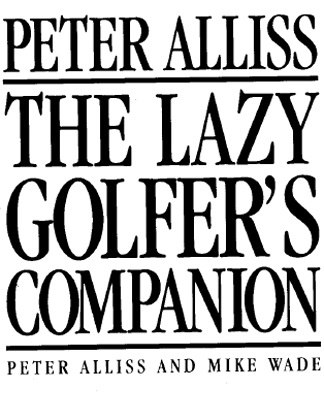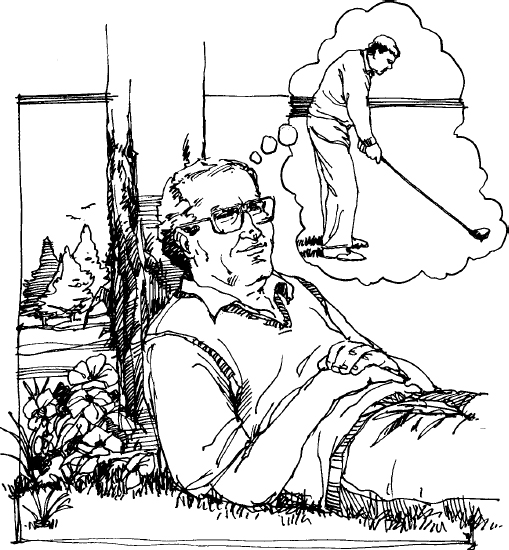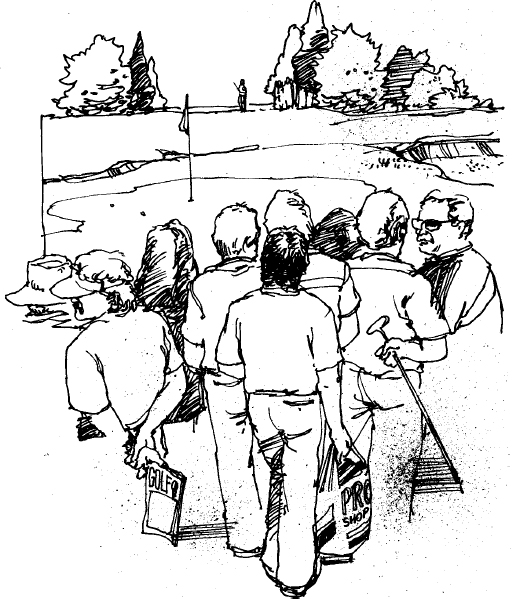
Полная версия:
The Lazy Golfer’s Companion




COPYRIGHT
HarperCollinsPublishers Ltd.
1 London Bridge Street
London SE1 9GF
www.harpercollins.co.uk
Copyright © Peter Alliss and Mike Wade 1995
Peter Allis and Mike Wade assert the moral right to be identified as the authors of this book.
A catalogue record for this book is available from the British Library.
Illustrations by Bruce Allard
All rights reserved under International and Pan-American Copyright Conventions. By payment of the required fees, you have been granted the nonexclusive, nontransferable right to access and read the text of this ebook on-screen. No part of this text may be reproduced, transmitted, downloaded, decompiled, reverse-engineered, or stored in or introduced into any information storage and retrieval system, in any form or by any means, whether electronic or mechanical, now known or hereafter invented, without the express written permission of HarperCollins ebooks
HarperCollinsPublishers has made every reasonable effort to ensure that any picture content and written content in this ebook has been included or removed in accordance with the contractual and technological constraints in operation at the time of publication
Source ISBN: 9780002187084
Ebook Edition © December 2016 ISBN: 9780008240509
Version: 2017-01-10
CONTENTS
Cover
Title Page
Copyright
Foreword
1. A Typical Weekend Fourball
2. The A to Z of Equipment
Distance or Control – That is the Question
The Right Mix of Materials
Green Lies
The Saville Row Option
Club Combinations
Balls for All Needs
3. The Lazy Golfer’s Swing Technique
The Classic and The Not So Classic Swing
Supertips from Top Pros
GASP
Comfort Zones
Swing Reflexology
4. Remedies For Slice and Hook
The Wrong Place at the Wrong Time
The Reverse Pivot
Spine Jerkers and Others
Hook as You Stand
5. The Easy Approach
Making a Pitch
The Gentle Roll
Chips Anyone?
6. Escape From The Sand
Sweeping the Long Shots
The Gentle Splash
How Far Behind, Open or Hard?
Up and Down in Two
7. The Final Stroke
Square to Square
The Sweet Spot
Speeding over the Breaks
The Writing on the Green
8. The Game Plan
No More Guesswork
Tactics from Green to Tee
Score on the Odd Pars
Never Give Up
9. Matchplay: The Lazy Golfer’s Game
Win Slowly
Seven Mistakes a Round
Nerves and Jitters
Playing as a Team
Lose One, Win One
10. Practice For Fun
Know Yourself
Trials and Try-outs
Great Games to Score
Practising on the Course
Index
About the Author
About the Publisher

PETER ALLIS WITH ARNOLD PALMER.
FOREWORD
I’ve known Peter Alliss for almost 35 years. We first met in 1960 Open Championship at St Andrews and then played against each other in the 1961 Ryder Cup at Royal Lytham. It was a terrific battle, which fittingly ended in a draw, and from then on our friendship grew.
Over the years, we have often discussed the great game of golf in all its details. We both agree that the average club golfer makes it much more difficult than it is. For one thing, he does not work at it, although in many cases the available facilities are not very generous and that discourages practice. But very few golfers have the right mental approach to the game, which brings success at club level in both medal and matchplay.
This is why this book is so important for the average golfer. Its sound instruction on clubs, swing problems (with ‘quick fixes’) and shotmaking techniques (from driving to putting) is very valuable. Its thoughtful advice on the mental side (especially on course management and matchplay tactics) is invaluable. All in all, it will help any golfer to improve his game quite dramatically.
Arnold Palmer
1

A TYPICAL WEEKEND FOURBALL
It is 09.48 on a sunny Saturday; the scene of a typical club fourball, almost anywhere in the world. On the first tee, Doug and Brian have been loitering around for four or five minutes, swishing the odd club and talking sotto voce about share prices. With one eye on the clock, as their starting time is 09.50 (where on earth are Matt and Bob?) they are also wondering if they will finish the round in time for a leisurely drink. The ritual session at the nineteenth is indispensable for all.
The ‘early birds’, an assorted bunch of club members who tee off often at first light (possibly because wives demand they are back in “reasonable” time for shopping, visits or even gardening) are well over the horizon. Moodily they watch the four in front criss-crossing the fairway in the mid-foreground at an agonisingly slow amble.
They turn at the squeak of a trolley behind. Matt puffs up followed closely by Bob, who is struggling into a sleeveless sweater. “Had to stop at the garage,” he says. “Just in time, as usual.”
They toss their balls for partners, the two lying closest together playing together and Bob draws Doug, as he feels he does far too often. They are a well (or ill-) matched pair. Bob habitually slices, while Doug mostly has a horrendous hook (not surprising as you couldn’t hammer a nail in with his right hand under grip).

TOO MANY THOUGHTS CAN FREEZE THE SWING.
Bob, having the honour, tees up first and squints down the fairway. The four figures in front have now advanced some three hundred yards. “Safe enough to drive off, I suppose?” He looks balefully at the shallow bunker to the right, one hundred and seventy yards out. Nine times out of ten that’s where his drives at this hole end up . . . but he ignores it.
Squaring his stance, sucking in his stomach as much as possible, he aligns down the dead centre of the fairway, waggling his driver thoughtfully. Then he freezes for several seconds, swing ‘thoughts’ jostling in his mind.
Hover the clubhead behind the ball (like Greg). Back low and slow (like Nick). Cock the wrists easily (like Seve). Coil fully around (like John Daly). Drive with the knees (like Jack). Finish high (like Matt – who has been telling him to for the last six weeks).
His resulting swing is not a thing of beauty. It is cumbersome, at best. The ball, powdered by the dust of a small divot, squirts off centre-rightish and rolls across the right hand edge of the bunker. Behind him Doug grunts “Shot”. At least the ball missed the bunker.
The others tee off with similarly predictable results. Doug a long way and deep into the left rough; Brian in the right bunker and Matt (who keeps telling them for quite a while after that he’s lifting his head) a topped ‘worker’ centre-right. Happily off without any disasters (as members of the next fourball are approaching the tee) they move after their drives, talking amiably. Another typical weekend fourball ready to enjoy a pleasant round.

ALWAYS TAKE A WEDGE FROM DEEP ROUGH.
But do they have fun? Well of course they enjoy the next four hours or so, after a fashion. Golf is a fulfilling, pleasurable game and around about the sixteenth, with a couple of balls on the match and one pair playing as many indifferent shots as the other, the competition is satisfying. It would be a lot more fun though if all competed better, if all played as well as they thought they were capable of playing.
They could too . . . with just a little thought and a little careful preparation, which is how this book will help you if you are a high-handicapper, whether you’re a municipal or a club golfer. It is not written for the absolute beginner, nor for the player who believes that he can emulate Greg, Payne, Nick or Seve. It is written for the golfer who has been playing for a few (or many) years. It won’t change your swing dramatically, but it will help you to lessen its most negative effects. It won’t necessarily get you pin high out of a bunker, but it will help you get out. Above all, it will help you to play better, and score better which means you should get a lot more fun out of your golf.
Much of our advice may appear to be just common sense. But common sense and clear thought appear to desert the majority of normally intelligent club golfers the minute they head for the course.
Now there are an estimated seven million golfers in Europe, including small active contingents on the fringes in countries like Hungary and Estonia, and some 24 million in the USA. It is hard to compile the many millions who play along the Pacific Rim, largely because a majority of Japanese golfers play their game mainly on driving ranges, but all club players have certain common factors, world-wide. Their average handicap is 20 – and 80 per cent slice.
Many are desk-bound and overweight. They practice little and rarely improve, yet they are very keen supporters of the game. They buy lots of equipment, attend championships, scrutinise golf books, videos and magazines (from which they glean ‘tips’ which they apply haphazardly for a couple of rounds). They also get invited occasionally, through a friendly sponsoring company, to play in Pro-Ams.
There are Pro-Ams on the day before most tournaments, which give the Tour pro a chance to practice on the course and earn some valuable prize money as well. So Tour pros sum up the abilities of their (usually three) Pro-Am partners fairly quickly. None of them can damage the team’s (pro’s) score, but if one or two can improve it on a hole where their handicaps count, it’s worthwhile. As a result, on the first tee the pros watch ‘their’ amateurs like hawks. By the fifth or sixth hole they offer a little advice here and there which starts to bring about the odd par where bogey had been the norm.
The pro would have had a few pithy things to say to the members of our fourball after the first 380 yards par four hole. Something diplomatic to Bob (who with 200 yards to go had taken a 3-iron, never having hit one more than 180 yards, and had buried his ball in knee-high rough short on the right) like: “Don’t swing your body at the ball. Try and hit it with your hands and arms instead.” Or to Brian (who had taken two to get out of the bunker) like: “Don’t try and lift the ball off the sand. Take plenty of it.” Or to Doug (who had tried a 4-iron out of deep to advance it 25 yards) like: “Next time use your wedge and aim for the nearest bit of fairway.”

CASUAL GOLFERS ARE KEEN SUPPORTERS AT THE GAME.
With Matt he would be reserving judgment because after another skinny one, Matt had pitched to the fringe and fired a putt that rocketed in off the pin. His fluky par won the hole over two bogeys and a double. They had all left the green happily. Things would certainly improve once they got into their game.
How different it could all have been. Bob’s dream when he stood on the first tee (sorry to be picking on him but he’s a good example of a typical club player), was to crack a drive quail-high 250 yards down the middle. The reality we know, but with a little common sense he could have played the hole much better, while making the best of what he had in terms of swing and ability.
First, arriving “just in time” without a chance to loosen up virtually guarantees a cranky shot. That is not to say you should spend half an hour on the practice ground before every round: in the time-stressed 1990s few have time to spare and club golfers mostly hate practising. And indeed, how many golf clubs in the UK have decent practice facilities of any sort? But virtually everyone has played tennis at some time. Would you consider going straight onto a court and with your first movement hit a serve in the first ‘scoring’ game, even if it’s a friendly match? Of course not. You’d have a short knock-up first – and that is what club golfers should do, even if it’s a few putts on the putting green and a couple of chips.
Second, Bob did not use the grey matter between his ears which constitutes a large part of the simple game of golf. He had been in a bunker at the first nine times out of ten, yet he still aimed straight down the fairway. Knowing he always sliced, he should have teed up on the right hand side of the tee and aimed at the left hand rough where Doug ended up. With his usual swing, he would probably have ended up in the middle of the fairway and very likely have hit the ball twenty yards or so further.
Third, no one can swing fluidly, if they have umpteen swing thoughts jostling in their minds. You can never get a natural-looking, effective, repeating swing that way. At the most, you can hold one swing thought for the day (“Swing slower” is often a good one).
Fourth, Bob’s second shot to the green was a combination of nonsense and vanity. Once you’ve got off the tee, it’s the second shot that make the difference in scoring for the player. Underclubbing is the major fault (as it often is on long par three holes).
Finally (although there are many other lessons to be learned from this role model performance) Bob took his driver off the first tee. Now it’s all very well hitting your drive at the start if you’ve hit quite a few on the practice ground before the game. But in Bob’s case, driving off with the most difficult club in his bag did not make sense. Added to which his driver had a swing weight and lie designed for a six foot four, athletic 20-year-old, which Bob certainly is not!
And that brings us to one of the most important factors for the club golfer, the ‘tools of the trade’ – your golf clubs.
Конец ознакомительного фрагмента.
Текст предоставлен ООО «ЛитРес».
Прочитайте эту книгу целиком, купив полную легальную версию на ЛитРес.
Безопасно оплатить книгу можно банковской картой Visa, MasterCard, Maestro, со счета мобильного телефона, с платежного терминала, в салоне МТС или Связной, через PayPal, WebMoney, Яндекс.Деньги, QIWI Кошелек, бонусными картами или другим удобным Вам способом.
Вы ознакомились с фрагментом книги.
Для бесплатного чтения открыта только часть текста.
Приобретайте полный текст книги у нашего партнера:
Полная версия книги
Всего 10 форматов



